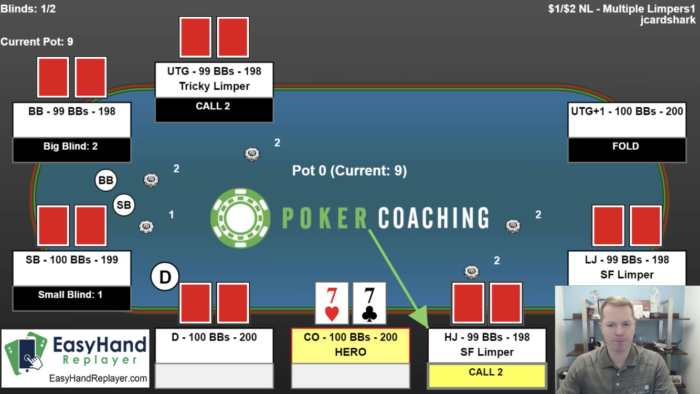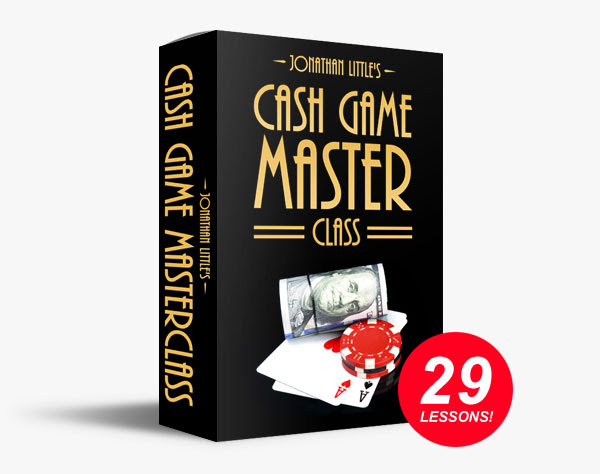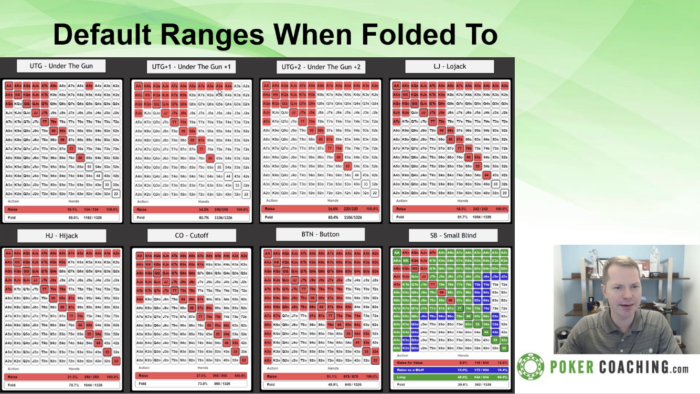They say one of the toughest things about writing is just getting the first words down on the page. Boy was that true when it came to reviewing Jonathan Little’s Cash Game Master Class! I sat here for far too long trying to think about a catchy way to grab you, as you begin reading.
So instead, let’s just go with substance over style.
Over eight live sessions since taking Jonathan Little’s Cash Game Master Class, I haven’t recorded a single loss. I’ve also had my biggest ever winning session at $1-2 NLHE during this stretch.

In several online sessions since, I’ve not only produced a much better winrate than in recent months, but my desire to play online No Limit Hold ‘em has been rejuvenated.
So, did THAT grab you enough? 😀
Jonathan Little’s Cash Game Master Class: Comprehensive Cash Game Training
Fair warning, if you plan on tackling this 30-video series, get ready to work. This is not a series for beginners. There’s gonna be some math. That all said, the depth this series provides is incredible.
Every aspect of cash game play you can imagine is covered, not just in strategies for every street of play (with tons of examples throughout), but how and when to implement both exploitative and GTO play.
Before Little gets into street-by-street play, the first couple of videos introduce the series, touching on things such as game selection, stack sizes, rake, player types, exploiting weak opponents, equity, and a couple of hand examples. Nothing too crazy yet; just a few things to think about while you fasten your seat belt.
After that though, you better be strapped in, because it’s one heck of a ride!
The third video is an introduction to probably the most important thing that will be stressed throughout the entire series: ranges!

No…. not THAT kind of range…
Long gone are the days of ‘putting your opponent on a hand’. This is 2023, friends. Ultimately, it doesn’t necessarily matter what those two cards in front of you and your opponents are. It’s all about what they could be.
Throughout these videos, you will be constantly prompted to think about ranges, both yours and your opponents’. While there are some specific examples on how certain hands can be played, thinking in terms of ranges is the predominant factor in how you should study and play your hands. This is a tool Little has utilized regularly in his Homework Challenges on Pokercoaching.com.
The video on ranges introduces the concepts of range construction, balancing, counting combinations, blockers, and math-based call/fold spots.
I should mention at this point that while there is a good deal of GTO-based theory and strategy in the series, Little does stress the importance of exploitative play as well, especially at lower stakes where there will be a larger population of weaker players. Against them, exploitative play is just going to be far more profitable. In other words, trying to balance a 4-betting range against a nit under the gun just ain’t gonna work. You’re just going to smash into those aces every time.
After that, the meat of the series is basically broken into sections of multiple 10- to 20-minute-long videos discussing aspects of pre-flop, flop, turn, and river play. This is followed by a few videos covering such topics as shallow and deep stacked play, straddled pots, bankroll management, seat and game selection, tells and more.
Ed. Note: PokerCoaching.com also offer some excellent resources for tournament players, such as the 30-Day Tournament Preparation Challenge. See our review of that here.
Jonathan Little’s Cash Game Master Class: Pre-flop Play
This section consists of 9 videos entitled: Pre-flop Bet Sizing, Pre-flop When Folded To, When Your Raise Gets 3-bet, Facing Limpers, Facing a Raise, Facing a Raise and a Call, When You Call and Get 3-bet, Facing a Pre-flop Raise and 3-bet, and Facing a Pre-flop 4-bet.
Pre-flop play is the most heavily discussed element in the series, and for good reason. As Little has imparted in many of his teachings, the first decisions you make in a hand will set you up for success during the rest of the hand. Remember kids, poker actually isn’t about winning and losing, poker’s about making the right decisions. (Thanks Doyle Brunson Poker After Dark intro voiceover!)
The bet sizing section discusses the importance of sizing your pre-flop raises correctly. Little generally suggests a consistent approach, with a pot-sized raise being optimal (plus a little extra when playing out of position), but he also suggests that a more exploitative strategy against weaker players can be beneficial.
Along with your raise sizing, the next consideration is what range to raise with. Little provides a link to a multitude of charts for suggested open raising ranges for each position (based on 100 BB stacks and your opponents being capable players – deviation based on player type is of course encouraged).
Of note, Little dives significantly into small blind raising strategy, as it presents the most unique circumstances going forward in the hand, since you’re guaranteed to be playing out of position. That said, this bit is somewhat irrelevant in a raked game, however, as the common practice of ‘chopping’ and pulling back your blinds is encouraged.
One key topic introduced in the ‘Pre-flop When Folded To’ video is the mathematical formula for Minimum Defence Frequency (MDF). Ever wonder why the Big Blind defends so liberally and hits those “Big Blind Specials” on you? Some guy drew out on you after you 3-bet him pre-flop? Well, those things happen because in a lot of situations, they’re correct to be doing so. Little references MDF throughout the series in a variety of situations.
Speaking of those 3-bet situations, MDF, pot odds, implied odds, opponent type, position, and more important concepts are all discussed in this section. Additional charts are provided as well, breaking down what percentage of hands you should be folding / calling / 4-betting. Again, there’s the caveat of considering your opponents’ style and stack sizes.
Pre-Flop Charts – Live Cash Games: Check out these fundamentally sound ranges for Raise First In, Raise First In vs 3-bet, and Facing Raise First In. This is the first step to becoming a winning player! #Poker #Coaching #Preflop https://t.co/LGnAd4qWPz pic.twitter.com/A0yzgvNr4E
— Jonathan Little (@JonathanLittle) September 30, 2019
For small stakes players, the section on ‘Facing Limpers’ will prove invaluable. It weighs in at a meaty 23 minutes – the second largest in the series, and it’s my favourite video of the entire Jonathan Little Cash Game Master Class.
Before taking this class, I was a firm believer in never limping, and always coming in for a raise. Far too often, however, despite my best intentions, I’d still be facing a flop four or five ways, thinking everyone else in the hand was making the mistakes, not me. Yes, players shouldn’t even be in the hand with Q2s from early position, but if they’re going to limp, then call a raise with a hand like that, you need to play accordingly. You’re making as big a mistake as them if you’re not adjusting! As such, I’ve incorporated more limping into my game when playing $1-2 / $1-3, and some $2-5 games, and seen a world of difference because of it.
The bulk of the section discusses the idea of ‘tricky’ limpers, (you know those guys who limp Aces and Kings UTG, hoping to backraise? Oh sneaky sneaky!) and of straightforward limpers who limp many of their hands that are predominantly garbage. It also breaks down how to play against one, or a series of limpers, how to play based on position, and what to defend with correctly if a raise comes in after you’ve limped.

I would suggest watching the entire series in order to get the best results, but if there is one section for small stakes players to check out first to immediately help their game, I recommend this one.
For games that aren’t super passive limp-fests, the next sections on facing raises (and raises and calls behind) in pots pre-flop will take care of what you need to know. Should you flat call or 3-bet? should you squeeze? What if someone else squeezes? These questions and plenty more will be answered, as most are, with: “well, it depends!” However, all the factors to take into consideration are discussed, most importantly – what are your opponent’s ranges?!
The remaining videos that deal with pre-flop play discuss how to play when the action is 3-bet or 4-bet in front of you. These sections are a bit smaller, as the lessons are quite brief, especially when it involves smaller stakes games. Spoiler: PLAY TIGHT! THEY’VE USUALLY GOT IT! Little does discuss taking player types and game dynamics into consideration, especially in higher stakes games. Yet, when it comes to the $1-2 and $2-5 games, erring on the side of ‘they’ve got it’ is usually the most prudent play, unless you really know your opponent is capable of creative shenanigans.
Jonathan Little’s Cash Game Master Class: Flop Play
This section consists of six videos entitled: The Flop, Flop Examples, When To Bet Summary, When Facing A Flop Bet, Multi-way On The Flop, and Facing A Flop Raise
By now, hopefully students are adhering to Little’s mantra of developing a good pre-flop strategy, so when you get to the flop you can play reasonably well. If you play too much junk, you’re going to have more problems and tougher decisions to make.
The first of six videos on flop play is the longest, at almost 22 minutes, with opponent types, position, and the usual considerations discussed, but the introduction of range advantage and nut advantage considerations are a major talking point. In a nutshell, this section breaks down when and how much you should be betting based on who has the range and/or nut advantage. Far too many players blindly c-bet and play the flop without giving thought to these ideas. This video will teach you how to consider these factors, as well as to exploit players who don’t.
A video of examples incorporating the concepts discussed in the first video follows this up, using position-based ranges, not specific hands. There’s also a cool hand example that suggests a 1 BB c-bet on a J55 flop. (Plus how to consider MDF if someone tries it on you!)
Next up is the ‘When To Bet Summary’. It’s pretty self-explanatory, but it’s quality information based on basically every situation on the flop.
Those players who blindly fire out c-bets with minimal to no thought are discussed in the ‘When Facing A Flop Bet’ video. Your consideration of your opponent’s range is the key factor in constructing an optimal flop play. Are they polarized or linear? What are their tendencies? Who has the nut advantage? Who has the range advantage? There is a lot to consider when facing a flop bet, and if you take the time to do so and your opponents do not, chalk up another street of superior decision making to you!
Much like facing a pre-flop 4-bet in a small stakes game, simple straightforward play is suggested when it comes to playing multi-way on the flop. C-betting polarized ranges three ways can be done, but with four players or more contesting the hand, Little suggests reigning it in and not getting out of line.
There are plenty of talking points in this section, including consideration of your opponents’ ranges (as always), situations in which raising to clean up equity can be pulled off, and avoiding reverse implied odds!
There are also several examples provided with varying positions and flop textures to see these teachings at work.
The final video on flop play is what to do ‘when facing a raise’. Again, the assessment of your opponent’s range is the first factor to consider. The range / nut advantages, player type, blockers and the game’s stakes are all factors that can impact a player’s decision. That flop raise in a $1-2 game can mean something a whole lot different than in a higher stakes game.
Recognizing players who overvalue top pair and stack off against your superior hand is a huge money maker at the smaller stakes. However, not recognizing when your value bets are just dead to a player’s raising range can torch your bankroll.
As usual, accompanying examples support this section.
With a combined 15 videos on pre-flop and flop play, the amount of instruction is intense and truly effective. It’s impossible to give a complete breakdown of all the elements in these videos in a review. They really must be experienced to get the full gist of everything Little presents. Trust me though; these videos are the heart of the series and will set you up extremely well for play on the turn and river.
Jonathan Little’s Cash Game Master Class: Turn Play
This section consists of two videos entitled: The Turn and Turn Examples
“The turn is not some mythical street where people get lost. It’s just one more betting round where the same concepts apply.”
Many players get lost on the turn and I’ll fully admit that I’ve been one. I remember very specifically following a losing session at The Mirage this summer coming away feeling very shaken about my turn (and river) decisions. I wrote a note to myself to study these streets more, so when the opportunity to take Jonathan Little’s Cash Game Master Class came about, I was thrilled with how much confidence it instilled in my late street play.
The turn is just the next street in the hand, where if you’ve made good decisions leading up to this point in the hand, there’s really no reason you can’t keep making them and continue to play the hand confidently.
All the concepts discussed thus far also apply to the turn. Again, range analysis is a key factor, based on the actions on the flop, both heads-up and multi-way. What to do with and against polarized and linear ranges is also discussed.
Ultimately, Little suggests that the turn isn’t really that different than the flop. You just want to have fewer bluffs in your range, and you want to get closer to showdown with your marginal made hands.
The examples video follows up with an extension of the hands from earlier pre-flop and flop example videos, including the next steps in the 1 BB c-bet hand.
Jonathan Little’s Cash Game Master Class: River Play
There’s just one video in this section, entitled The River. The first thing Little mentions in this video is that this is where most of the players “drown”. Yup.
If you’re playing well and polarized, you need to be giving up on some more of your bluffs. This was a HUGE hole in my game that I’ve worked on plugging. Far too often players (myself included) blindly think that if they’re bluffing when they get to the river, that third barrel has to be fired. Consideration of ranges be damned, I’m getting that bluff through! Nope. Bye-bye money.
That said, exploiting weak opponents on the river can be done with proper bet sizing if you have a good feel for their tendencies. Against competent opponents, however, Little stresses the importance of balance and considering MDF.
I was wowed by how much depth there can be to river play. We’re going to be counting combos, thinking about blockers, and doing some math here, especially when it comes to reaching the river with a polarized range. More topics include overbetting (you might be surprised how profitable this can be in small stakes live games, as I’ve recently discovered), betting for thin value, bluffs, and multi-way situations.
Jonathan Little’s Cash Game Master Class: Full Hand Examples
Again, just one video in this section, but this is the time to put everything we’ve learned together. This video contains over 30 minutes of full hand examples. Tons of hands, start to finish. GTO and exploitatively, it’s all here.
Jonathan Little’s Cash Game Master Class: Last Lessons
This final section includes seven videos entitled: Shallow Stacked Play, Deep Stacked Play, Short-Handed Play, Straddled Pots, Bankroll Management, Other Topics, and Final Thoughts.
Now that we’ve given our game an overhaul, it’s time to discuss some other issues that can come into play.
First up are tips on short stack and deep stack play. To be fair, these sections may not be seen as overly groundbreaking by more experienced players, but hearing how Little expands on the ideas is certainly worthwhile.
The shallow stacked section (sub 40 BB) discusses the increased value of high cards, the decreased value of hands with implied odds, and the underrated value of fold equity. This is well elaborated on with a formula showing just how profitable it can be to shove versus a late position raise.

The deep stacked section (100 BB +) discusses the increased value of hands with implied odds that can make the nuts, and how suited connectors that make marginal flushes and straights can win, but are often overrated.
The differences between lower- and higher-stakes games are also discussed. It’s far less likely in a low-stakes game that an opponent is piling in money with a nut blocker type hand. Again though, know your opponent!
Another series of examples is provided, including one that shows the problems with suited connectors if the pot starts getting huge.
The video on short-handed play is the shortest in the series because, really, there are only a couple of considerations to make. As the table gets shorter, you’re just eliminating the early position player ranges (UTG, UTG+1 etc). Also, many players adjust incorrectly (either playing too loose, or too tight – if they still give the first player to act an early position range!)
Next is a section on straddling. I loved this video for no other reason than that I share Little’s beliefs on straddling: we both hate it! There really is no strategic benefit to straddling, other than wanting to play bigger and gamble more. If others want to do it, fine, let them; but now we’re going to be ready to play well against them.
Button straddling is more reasonable, but it’s bad for the game, and especially for the blinds because now they are essentially playing UTG and UTG +1. You don’t want them folding out their garbage hands because of that. You want them contesting the pot!
I’ll include a fun story with regards to this, as it can be instructive. Recently I played in a game where the whole table had to agree to allow a player to button straddle. I sat in the SB, to the direct left of a player who wanted to do this. I was the only person to object, which they did not take kindly to. The player was already quite obnoxious, and despite my efforts to calmly explain the logic behind my protesting, they decided to go to war with me verbally and on the felt. As this had tilted the player so surprisingly much, I was able to take advantage of their reckless aggression against me and stack them three times in an hour!
To recap: Don’t straddle. Learn to counter the straddle.
Proper bankroll management is a topic many recreational players either don’t adhere to, or if they do, have many questions about. Different people will have different opinions on how many buy-ins you should have to play at a certain level, which Little does, but he also incorporates winrate into calculating what you should be playing. Shot taking and when to move up are discussed (when your bankroll is 1.5x what you should have to comfortably be playing your current level, you can safely move up or take a shot). Little also stresses having discipline with your bankroll. Do not press your risk of ruin if variance has gotten the better of you at your current level. Suck it up, work on your game and move down! I unfortunately had to do this recently, but thanks to this course I’m moving back up.
The penultimate section is a collection of other topics that Little touches on briefly such as game selection, seat selection, what makes for a “good” game, rake, room promotions, buy-in sizing, mindset, and tells. Of note in the tells section is his recommendation of Zachary Elwood’s collection of books/videos on the topic.
LEARN MORE: Reading Poker Tells Video Series
Finally, Little wraps up the series with a thank you and a few last tips and reminders. If you’ve made it here and watched all 30 videos, congratulations, and get excited for what’s coming to you at the tables!
Jonathan Little’s Cash Game Master Class: Worth the Price!
I’ve always been a fan of Jonathan Little’s teachings, but I honestly can’t say that any poker course or training tool I’ve ever studied has had such an immediate positive impact on my game like this Cash Game Master Class has.
I know my graph with which I started out this course review only presents a very small sample size, and a lot had to go well (and not go wrong) for that largest-ever win I scored. Yet, a lot of what I’ve learned from this course has helped me maximize profit and minimize loss in situations I previously wouldn’t have. At the end of a session, knowing I’m leaving a winner has been nice, but above all I’ve been truly satisfied and confident in how I played and the decisions I’ve made.
With that said, I’m glad to once again be moving up in stakes, knowing my game is better than it’s ever been. Yours can be too. It’s just a couple of clicks away at Pokercoaching.com.











Comments